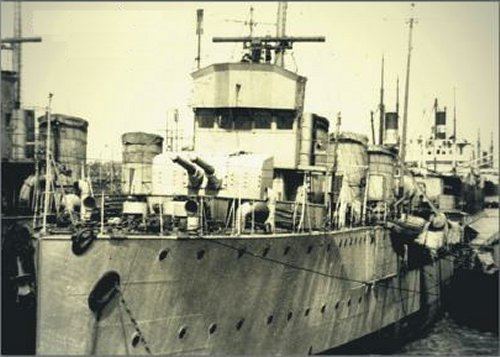Name Aquila class Succeeded by Regele Ferdinand class Retired 4 | Builders Pattison, Naples Completed 4 | |
 | ||
Operators Regia Marina
Romanian Naval Forces
Soviet Navy
Spanish Navy | ||
The Aquila class were initially intended as a group of destroyers built in Italy for the Romanian Navy, based on Romanian specifications. However, they were completed as scout cruisers and commissioned by the Italian Navy, with two being sold to Romania in 1920 and rearmed as destroyers only in 1926. The ships fought in both world wars, but for different owners and had a complex history.
Contents
History
In 1913, the Romanian Government ordered a class of four large destroyers from the Pattison yard in Naples, Italy. The four ships were named Vifor, Viscol, Vârtej and Vijelia. The Italian Government requisitioned the ships in 1915 upon entering the First World War, renaming them Aquila, Falco, Nibbio and Sparviero. The four ships were significantly larger than contemporary Italian destroyers and were rated as Esploratori or scout cruisers. Due to a shortage of light cruisers, three of the four warships were each armed with three single 6-inch (152 mm) and four 76 mm (3.0 in) L40 guns, except Falco, which was armed with her originally-intended 120 mm guns.
After the end of the First World War, two of the ships (Sparviero and Nibbio) were re-sold to Romania, being renamed Mărăști and Mărășești. They arrived at Constanța in 1920. The other two ships were retained by Italy until sold to the Nationalist faction of Spain in 1937. Mărăști and Mărășești were effectively converted from scout cruisers to destroyers during their 1925-1926 refit at the Galați shipyard in Romania, when their 6-inch guns were removed and later used as coastal artillery (such as the Tudor battery near Constanța with three guns). The two warships were subsequently sent to Naples, where they were rearmed with two twin 120 mm guns in two turrets and a single 120 mm gun (the latter being removed during World War II).
Both ships were active during the Naval war in the Black Sea in World War II, chiefly convoying supplies between Romania, the Crimea and the Bosphorus. On 26 June 1941, Mărăști helped repel a Soviet naval attack against the main Romanian port of Constanța, together with the destroyer Regina Maria and the minelayer Amiral Murgescu. Surprised by the level of resistance and the accuracy of the return fire, the Soviet fleet withdrew, losing the destroyer leader Moskva into a Romanian minefield, laid by the Romanian minelayers Amiral Murgescu, Regele Carol I and Aurora on 19 June. Her sister ship Kharkov was damaged by the German coastal battery Tirpitz while the cruiser Voroshilov was also damaged by Romanian mines. During the battle, Amiral Murgescu claimed to have shot down two Soviet aircraft and Mărăști claimed one. On 7 July 1943, Mărășești reported to have sunk the Soviet M-class submarine M-31 with depth charges, however this claim was proven to be erroneous. Both ships were surrendered to the Soviets in August 1944 on the Capitulation of Romania and were incorporated into the Black Sea Fleet as Lovkiy (Ловкий, ex-Mărăști) and Lyogkiy (Лёгкий, ex-Mărășești) but were returned to Romania in October 1945, served in Naval Forces of Romanian People's Republic under the numbers D12 and D11 and scrapped in the 1960s.
Aquila and Falco were sold to the Nationalist Spanish Navy, which, in 1937 only had one destroyer available (Velasco). They were renamed Melilla and Ceuta, and saw heavy service, in spite of their poor condition. To conceal the fact that Italy was selling ships to Franco's side, they were often referred as Velasco-Ceuta and Velasco-Melilla. After the war, they were retained by the Spanish Navy.
Ships
The former Aquila and Falco served in the Spanish Navy as Melilla and Ceuta until 1949
